Kutz M. Handbook of materials selection
Подождите немного. Документ загружается.


7 DRILLING MACHINES 873
as the diameter is reduced. The cutting speed is actually zero at the center. To
avoid the region of very low speed and to reduce high thrust forces that might
affect the alignment of the finished hole, a pilot hole is usually drilled before
drilling holes of medium and large sizes. For the case of drilling with a pilot
hole
22
Q ⫽ (d ⫺ d )F
p
4
3
⫽ (d ⫹ d )(d ⫺ d )F in. /min (50)
pp
4
Due to the elimination of the effects of the chisel-edge region, the equations for
torque and thrust can be estimated as follows:
2
d
p
1 ⫺
冉冊
d
M ⫽ M (51)
p
0.2
d
1
冤冥
1 ⫹
冉冊
d
d
1
1 ⫺
d
T ⫽ T (52)
p
0.2
d
1
冤冥
1 ⫹
冉冊
d
where d
p
⫽ pilot hole diameter
Alignment charts were developed for determining motor power in drilling.
Figures 15 and 16 show the use of these charts either for English or metric units.
The unit power* (P) is the adjusted unit power with respect to drilling conditions
and machine efficiency.
For English units,
2
D
HP ⫽⫻ƒ ⫻ N ⫻ P*
m
4
12V
N ⫽
D
2
D 12V
HP ⫽⫻ƒ ⫻⫻P*
m
4
D
⫽ 3 D ⫻ ƒ ⫻ V ⫻ P*
As
For metric units,
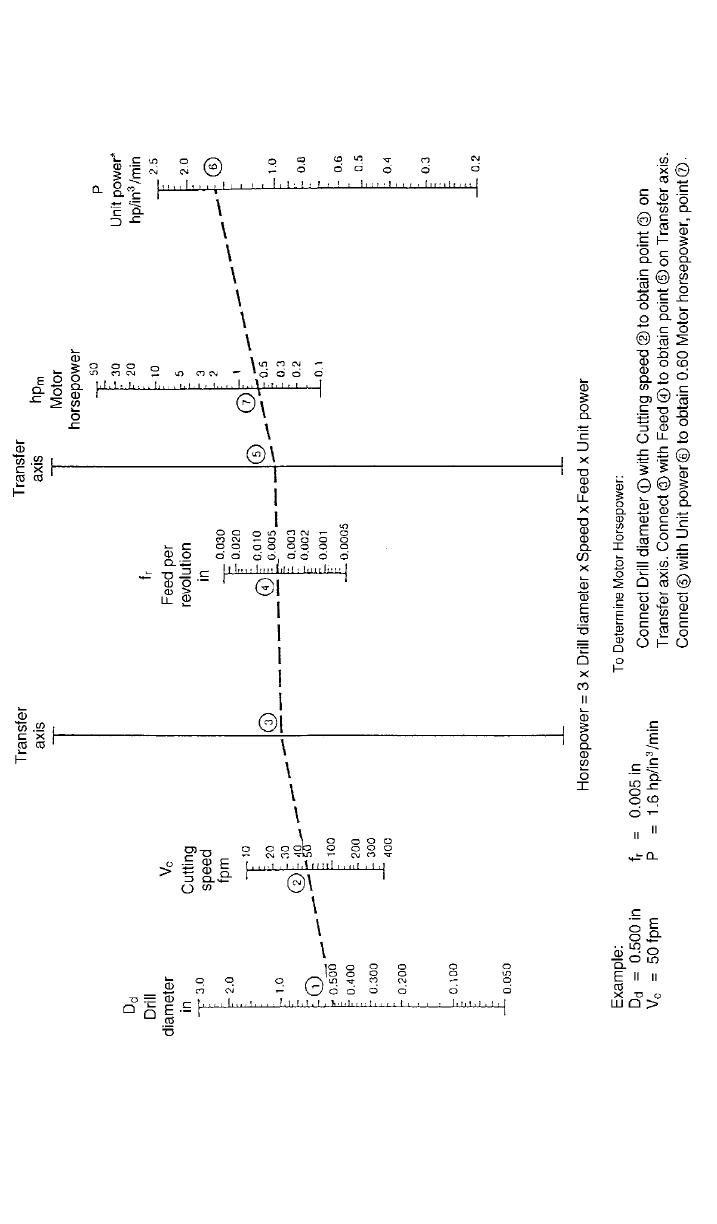
874
Fig. 15 Alignment chart for determining motor horsepower in drilling—English units.
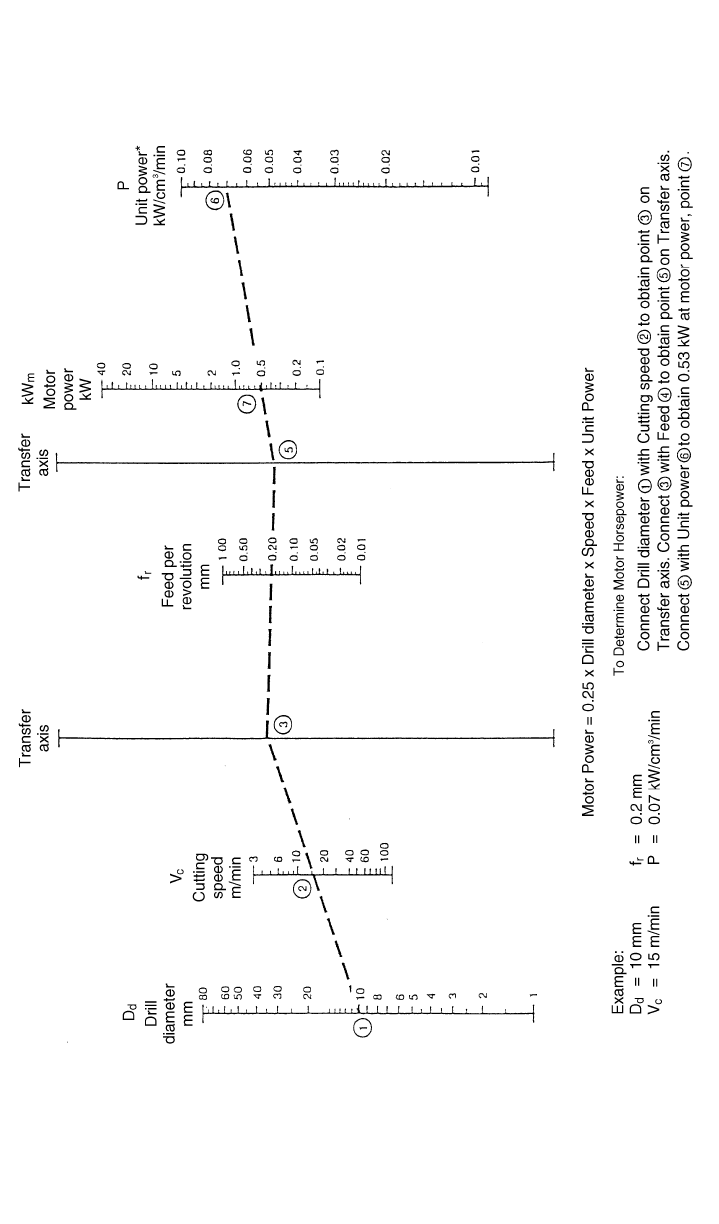
875
Fig. 16 Alignment chart for determining motor power in drilling—metric units.

876 PRODUCTION PROCESSES AND EQUIPMENT FOR METALS
Table 9 Oversize Diameters in Drilling
Drill Diameter (in.)
Amount Oversize (in.)
Average Max. Mean Average Min.
1
⁄
16
0.002 0.0015 0.001
1
⁄
8
0.0045 0.003 0.001
1
⁄
4
0.0065 0.004 0.0025
1
⁄
2
0.008 0.005 0.003
3
⁄
4
0.008 0.005 0.003
1 0.009 0.007 0.004
2
D ƒ
HP ⫽⫻⫻N ⫻ P
m
4 ⫻ 100 10
3
P*inkW/cm/min
1000V
N ⫽
D
2
D ƒ 100V
HP ⫽⫻⫻⫻P*
m
4 ⫻ 100 10
D
⫽ 0.25 D ⫻ ƒ ⫻ V ⫻ P*
7.1 Accuracy of Drills
The accuracy of holes drilled with a two-fluted twist drill is influenced by many
factors, including the accuracy of the drill point; the size of the drill, the chisel
edge, and the jigs used; the workpiece material; the cutting fluid used; the ri-
gidity and accuracy of the machine used; and the cutting speed. Usually, when
drilling most materials, the diameter of the drilled holes will be oversize. Table
9 provided the results of tests reported by The Metal Cutting Tool Institute for
holes drilled in steel and cast iron.
Gun drills differ from conventional drills in that they are usually made with
a single flute. A hole provides a passageway for pressurized coolant, which
serves as a means of both keeping the cutting edge cool and flushing out the
chips, especially in deep cuts.
Spade drills (Fig. 17) are made by inserting a spade-shaped blade into a
shank. Some advantages of spade drills are (1) efficiency in making holes up to
15 in. in diameter; (2) low cost, since only the insert is replaced; (3) deep hole
drilling; and (4) easiness of chip breaking on removal.
Trepanning is a machining process for producing a circular hole, groove, disk,
cylinder, or tube from solid stock. The process is accomplished by a tool con-
taining one or more cutters, usually single-point, revolving around a center. The
advantages of trepanning are (1) the central core left is solid material, not chips,
which can be used in later work; and (2) the power required to produce a given
hole diameter is highly reduced because only the annulus is actually cut.
Reaming, boring, counterboring, centering and countersinking, spotfacing,
tapping, and chamfering processes can be done on drills. Microdrilling and sub-
microdrilling achieve holes in the range of 0.000025–0.20 in. in diameter.
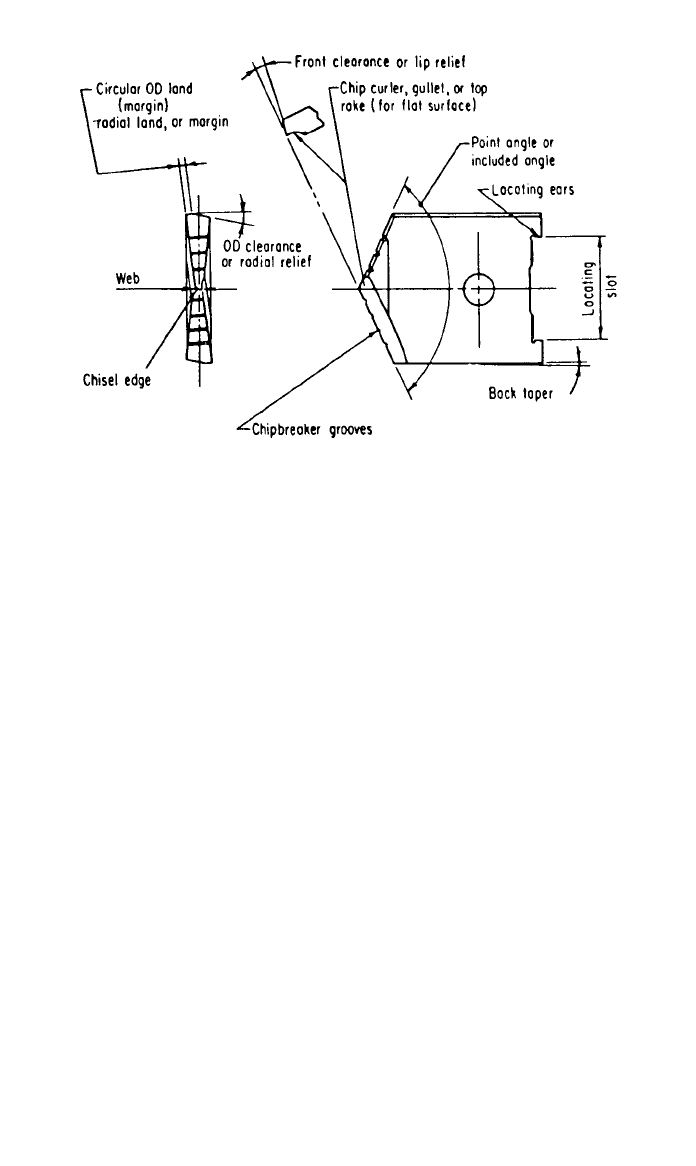
8 MILLING PROCESSES 877
Fig. 17 Spade-drill blade elements.
Drilling machines are usually classified in the following manner:
1. Bench: plain or sensitive
2. Upright: single-spindle or turret
3. Radial
4. Gang
5. Multispindle
6. Deep-hole: vertical or horizontal
7. Transfer
8 MILLING PROCESSES
The milling machines use a rotary multitooth cutter that can be designed to mill
flat or irregularly shaped surfaces, cut gears, generate helical shapes, drill, bore,
or do slotting work. Milling machines are classified broadly as vertical or hor-
izontal. Figure 18 shows some of the operations that are done on both types.
Feed in milling (F) is specified in inches per minute, but it is determined
from the amount each tooth can remove or feed per tooth (ƒ
t
). The feed in./min
is calculated from
F
⫽ ƒ ⫻ n ⫻ N in./min (53)
t
where n ⫽ number of teeth in cutter
N
⫽ rpm
Table 10 gives the recommended ƒ
t
for carbides and HSS tools. The cutting
speed CS is calculated as follows:
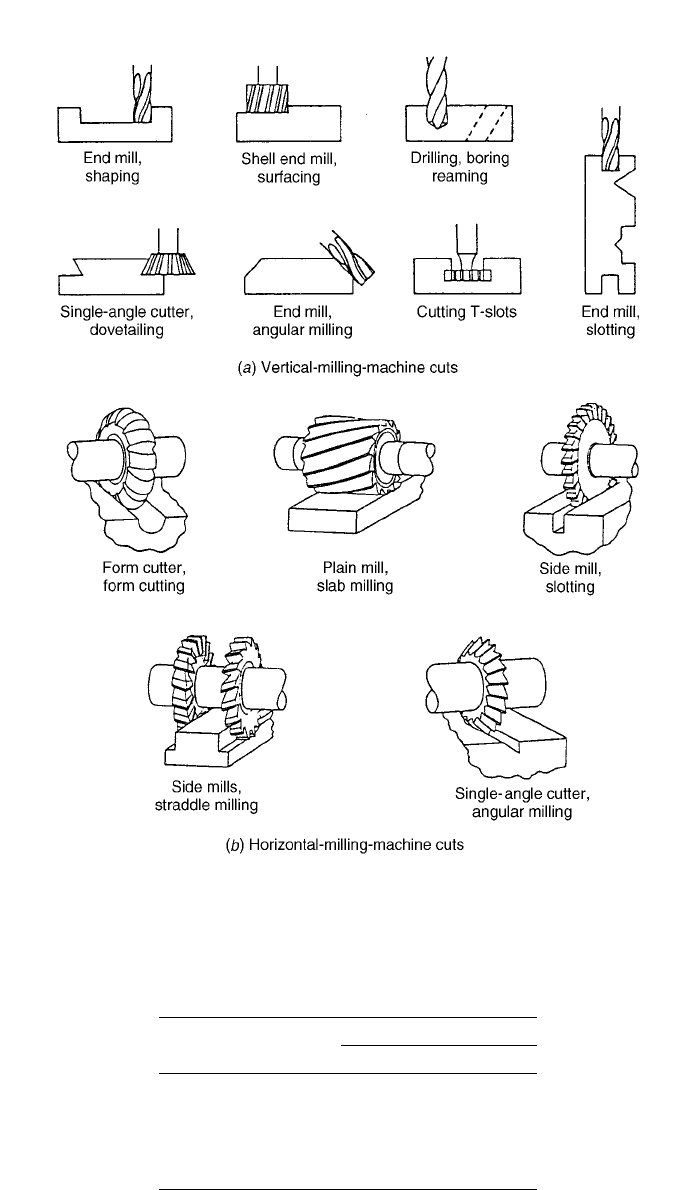
878 PRODUCTION PROCESSES AND EQUIPMENT FOR METALS
Fig. 18 Applications of (a) vertical; (b) horizontal milling machines.
Table 10 Recommended Feed per Tooth for
Milling Steel with Carbide and HSS Cutters
Type of Milling
Feed per Tooth
Carbides HSS
Face 0.008–0.015 0.010
Side or straddle 0.008–0.012 0.006
Slab 0.008–0.012 0008
Slotting 0.006–0.010 0.006
Slitting saw 0.003–0.006 0.003

8 MILLING PROCESSES 879
Table 11 Table of Cutting Speeds (sfpm) –Milling
Work Material
HSS Tools
Rough Mill Finish Mill
Carbide-Tipped Tools
Rough Mill Finish Mill
Cast iron 50–60 80–110 180–200 350– 400
Semisteel 40–50 65–90 140–160 250–300
Malleable iron 80–100 110–130 250–300 400–500
Cast steel 45–60 70–90 150–180 200–250
Copper 100–150 150–200 600 1000
Brass 200–300 200–300 600–1000 600–1000
Bronze 100–150 150–180 600 1000
Aluminum 400 700 800 1000
Magnesium 600–800 1000–1500 1000–1500 1000–5000
SAE steels
1020 (coarse feed) 60–80 60–80 300 300
1020 (fine feed) 100–120 100–120 450 450
1035 75–90 90–120 250 250
X-1315 175–200 175–200 400–500 400– 500
1050 60–80 100 200 200
2315 90–110 90–110 300 300
3150 50–60 70–90 200 200
4150 40–50 70–90 200 200
4340 40–50 60–70 200 200
Stainless steel 60–80 100– 120 240–300 240–300
Titanium 30–70 200–350
Fig. 19 Cutting action in up-and-down milling.
DN
CS ⫽ fpm
12
where D
⫽ tool diameter, in.
Table 11 gives the recommended cutting speeds while using HSS and carbide-
tipped tools. The relationship between cutter rotation and feed direction is shown
in Fig. 19. In climb milling or down milling, the chips are cut to maximum
thickness at initial engagement and decrease to zero thickness at the end of
engagement. In conventional or up milling, the reverse occurs. Because of the
initial impact, climb milling requires rigid machines with backlash eliminators.
The material removal rate (MRR) is Q
⫽ F ⫻ w ⫻ d, where w is the width
of cut and d is the depth of cut. The horsepower required for milling is given
by
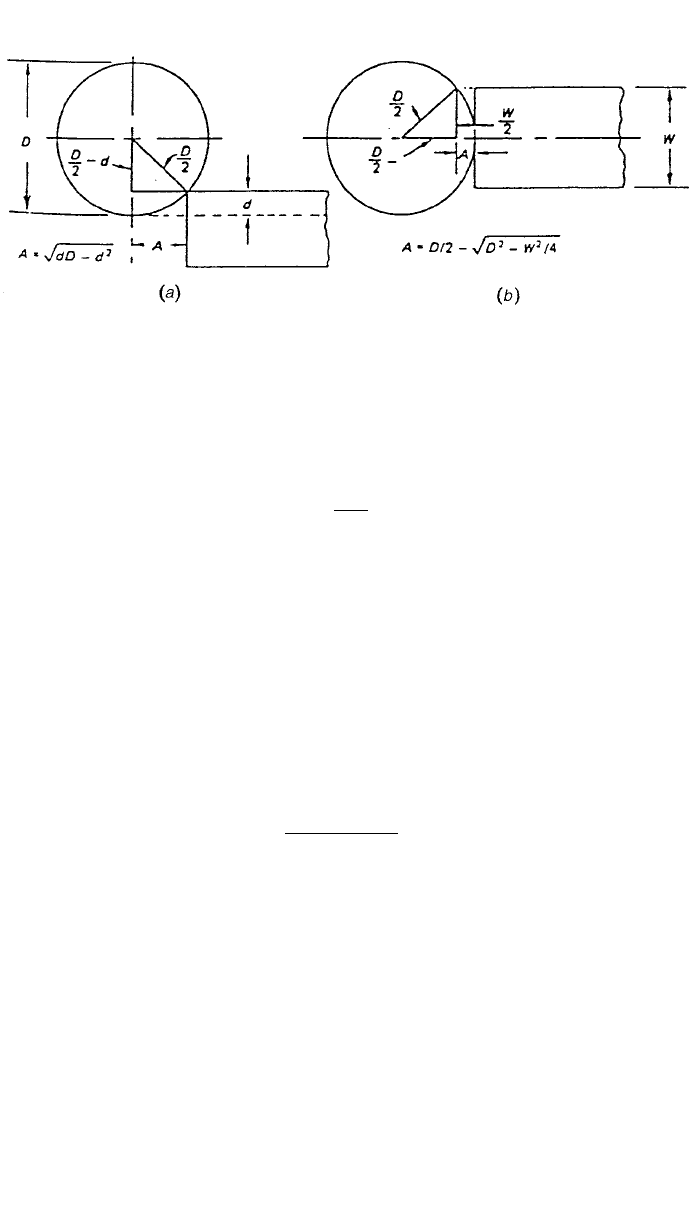
880 PRODUCTION PROCESSES AND EQUIPMENT FOR METALS
Fig. 20 Allowance for approach in (a) plain or slot milling; (b) face milling.
HP ⫽ HP ⫻ Q
c
Machine horsepower is determined by
HP
c
HP ⫽⫹HP (54)
mi
Eff.
where Hp
i
⫽ idle horsepower
Alignment charts were developed for determining metal removal rate (MRR)
and motor power in face milling. Figures 21 and 22 show the method of using
these charts either for English or metric units.
The time required for milling is equal to distance required to be traveled by
the cutter to complete the cut (L
1
) divided by the feed rate F. L
1
is equal to the
length of cut (L) plus cutter approach A and the overtravel OT. The machining
time T is calculated from
L
⫹ A ⫹ OT
T ⫽ min (55)
F
OT depends on the specific milling operation.
The milling machines are designed according to the longitudinal table travel.
Milling machines are built in different types, including:
1. Column-and-knee: vertical, horizontal, universal, and ram
2. Bed-type, multispindle
3. Planer
4. Special, turret, profilers, and duplicators
5. Numerically controlled
9 GEAR MANUFACTURING
Gears are made by various methods, such as machining, rolling, extrusion, blank-
ing, powder metallurgy, casting, or forging. Machining still is the unsurpassed
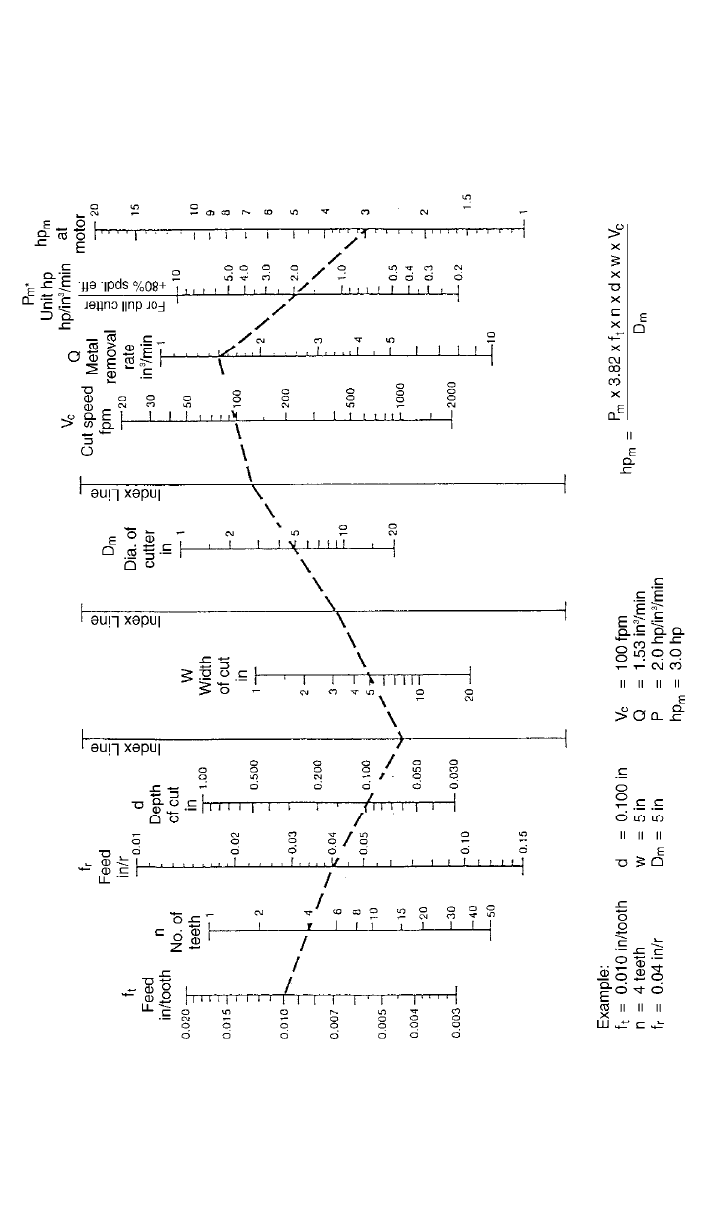
881
Fig. 21 Alignment chart for determining metal removal rate and motor horsepower in face milling—English units.
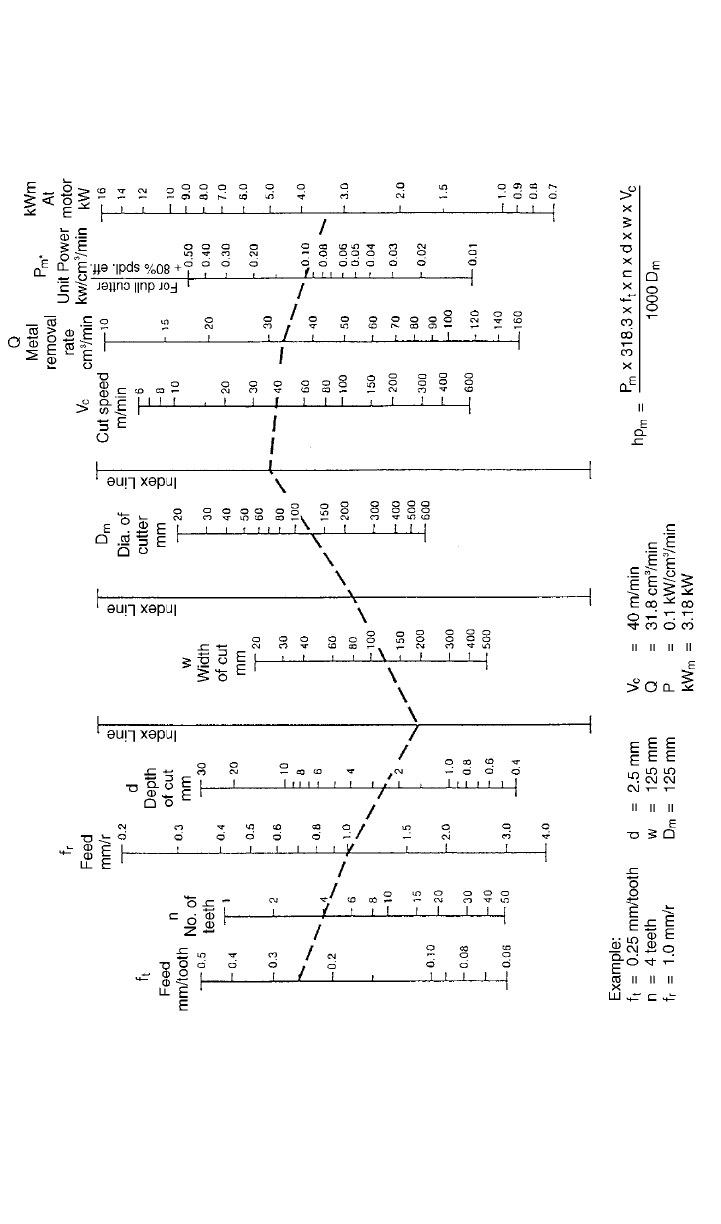
882
Fig. 22 Alignment chart for determining metal removal rate and motor power in face milling—metric units.
